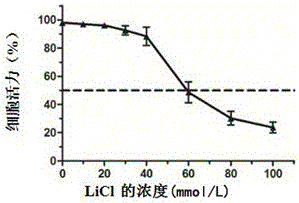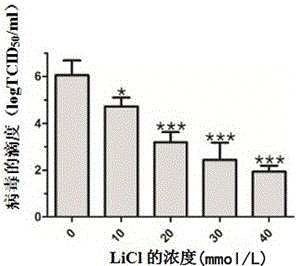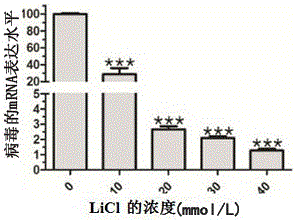Foot and mouth disease virus inhibitor using lithium chloride as effective component
A technology for foot-and-mouth disease virus and active ingredients, which is applied in the directions of alkaline/alkaline earth metal chloride active ingredients, antiviral agents, etc., to achieve the effects of clear and single ingredients, low cost and simple preparation
- Summary
- Abstract
- Description
- Claims
- Application Information
AI Technical Summary
Problems solved by technology
Method used
Image
Examples
Example
[0026] Test example 1 Cytotoxicity detection of LiCl
[0027] In order to detect the effect of LiCl on normal cell growth, the cytotoxicity of LiCl was tested using the Cell Counting Kit-8 (CCK8) kit. The specific operation steps are as follows: Transfer BHK-21 cells that grew well on DMEM cell culture medium to a 96-well cell plate. After the cells covered a single layer, discard the cell culture medium, wash 3 times with PBS solution, and then add 100 μL Drugs with serial concentrations (dilute LiCl to 10, 20, 30, 40, 60, 80 and 100 mmol / L with serum-free cell culture medium), set up three replicates of drugs with different concentrations, and set up a negative control (without Add drug) and blank control (no cells, only add culture medium), put them in a 37°C incubator for 48h. After rinsing with PBS, add 100 μL of 10% CCK8 solution to each well, continue to incubate in a 37°C incubator for 1-4 hours, and measure the absorbance value of each well at 450 nm with a microplat...
Example
[0029] Test example 2 Determination of the antiviral activity of LiCl against foot-and-mouth disease virus
[0030] The antiviral activity of LiCl against FMD virus was determined by the following protocol and verified by the following experiments. The specific operation steps are as follows: Transfer the BHK-21 cells that grew well on DMEM cell culture medium to 24-well cell plate. After the cells covered a single layer, discard the cell culture medium, wash 3 times with PBS solution, and inoculate each well. FMDV (MOI=0.1) was added with series concentrations of LiCl (10, 20, 30, 40 mmol / L, respectively), and three replicates were set up. At the same time, a control group without drug addition but inoculated with FMDV was set up. Incubate in a 37°C incubator for 48 hours. Discard the virus liquid, wash three times with pre-cooled PBS to remove free virus, add 400 μL of culture medium to each well, put it in a -20°C refrigerator for 3 times, and collect the virus liquid, cen...
Example
[0032] Test Example 3 Detection of FMDV Inhibition of Viral Replication Stage
[0033] 1. Virus adsorption stage
[0034]In order to test whether LiCl has an effect on virus adsorption to BHK-21 cells, the BHK-21 cells were transferred to a 24-well plate. After the cells covered a monolayer, the culture medium was discarded, and 200 μL of FMDV virus solution was added to each well (MOI= 0.1), then add 200 μL of different concentrations of LiCl to each well, so that the final concentrations of LiCl are 10, 20, 30 and 40 mmol / L respectively, set up a negative control without adding drugs, and put the cell plate in a refrigerator at 4 °C for 1 h , allowing only the virus to attach to the cell surface. Discard the virus solution, wash away the free virus with PBS, add 400 μL of culture solution to each well, put it in a -20°C refrigerator for 3 times, freeze and thaw repeatedly, collect the virus solution, centrifuge at 10,000 rpm for 10 minutes to remove cell debris, and use the...
PUM
 Login to View More
Login to View More Abstract
Description
Claims
Application Information
 Login to View More
Login to View More - R&D
- Intellectual Property
- Life Sciences
- Materials
- Tech Scout
- Unparalleled Data Quality
- Higher Quality Content
- 60% Fewer Hallucinations
Browse by: Latest US Patents, China's latest patents, Technical Efficacy Thesaurus, Application Domain, Technology Topic, Popular Technical Reports.
© 2025 PatSnap. All rights reserved.Legal|Privacy policy|Modern Slavery Act Transparency Statement|Sitemap|About US| Contact US: help@patsnap.com



